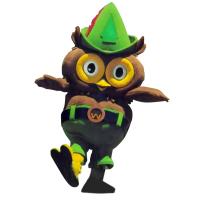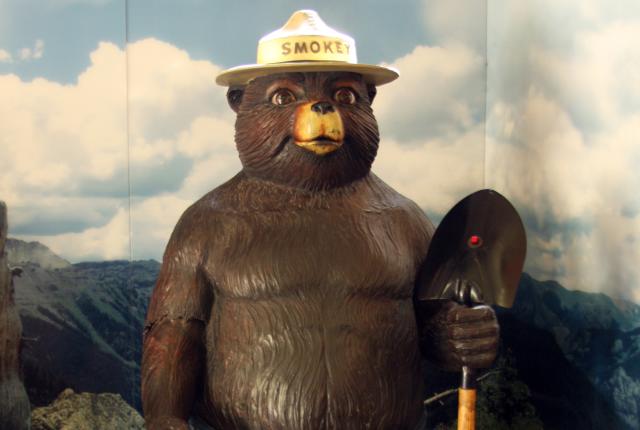“SMOKEY BEAR’S ‘GOTCHA DAY’ is in May,” says Smokey Bear Historical Park manager Mary Lavin, using the modern term for pet adoption anniversaries. The real-life orphan cub, who’d been badly burned in the Capitán Gap Fire in the Lincoln National Forest, in May 1950, came to represent the wildfire-prevention character introduced by the U.S. Forest Service in August 1944.
Smokey Bear Historical Park, where he was buried after his death in 1976, celebrated Smokey Bear Days from 2004 to 2019. Thanks to the park and the nonprofit Smokey Bear’s Hometown Association, the event returns May 3 and 4 with live music, demonstrations from educators and local conservation groups, a cornhole tournament, and giveaways of fire blankets and bike helmets. “It’s a fun way to come hear the conservation message and learn more about wildfire prevention and restoration,” Lavin says.
Rudy Wendelin’s original Smokey Bear paintings, featuring the evolution of the American conservation icon, are on display in the park from April 29 to May 10. “I believe his message has been, and always will be, that he’s inviting us to step into a cooperative role with him,” Lavin says.
DYNAMIC DUO
Smokey Bear was joined by Woodsy Owl in 1971 to promote conscientious environmental behavior through public service announcements and educational campaigns.
| WHO |  |
 |
| WHAT | Wildfire-prevention bear | Antipollution owl |
| WHY | “A bear is big and strong,” says Smokey Bear Historical Park manager Mary Lavin. “If a bear tells you to do something, you’re not going to say no.” | An owl is considered wise and relatable to many Americans in both rural and urban areas. |
| BIRTHDAY | Smokey’s character was launched August 9, 1944. In May 1950, a bear cub recovered from the Capitán Gap Fire became the living symbol of wildfire prevention. | Launched September 15, 1971. |
| CREATORS | Artist Rudy Wendelin was responsible for the U.S. Forest Service project for more than three decades, gradually shaping Smokey through the years. “He looks more human and more relatable,” says Lavin. | Harold Bell, a merchandising executive who managed the Smokey Bear account, is credited for creating Woodsy in partnership with Betty Hite and two U.S. Forest Service rangers. |
| ORIGINAL SLOGAN | “Remember, only you can prevent forest fires.” | “Give a hoot, don’t pollute.” |
| MODERN SLOGAN | In April 2001, the message was updated to “Only you can prevent wildfires.” | “Lend a hand, care for the land!” |
| POPULARITY | In a 1980s survey of iconic figures, “Smokey’s recognition was second only to Santa Claus worldwide,” says Lavin. The U.S. Postal Service even gave Smokey a stamp in 1984. | In 1976, Woodsy was known by 65% of U.S. households and 80% of those with a child under age 10. By 2002, only a quarter of adults were familiar with Woodsy. |
| SOCIAL MEDIA | 364,000+ followers on Facebook, 193,000+ followers on Instagram (@smokeybear) | 12,000+ followers on Facebook, 3,600+ followers on Instagram (@woodsy.owl) |
| ATTIRE | “Smokey always had dungarees, a leather belt, and a park ranger hat,” says Lavin. “Usually, he carries a shovel, so he’s always ready.” | Woodsy wears a Robin Hood–style hat with a red feather, green slacks, and a brown belt. A buff-looking Woodsy now sports a backpack and hiking boots. |
| SONG | Confusion around Smokey’s name comes from the 1952 song “Smokey the Bear.” Songwriters Steve Nelson and Jack Rollins added “the” to fit the rhythm. At Smokey Bear Historical Park, Lavin distributes copies of the sheet music on the back of the conservation pledge. | The Woodsy Owl campaign has used several songs, including “The Ballad of Woodsy Owl,” “Help Woodsy Spread the Word,” and “The Woodsy Owl Song,” the latter of which was recorded by “Weird Al” Yankovic’s drummer. |


